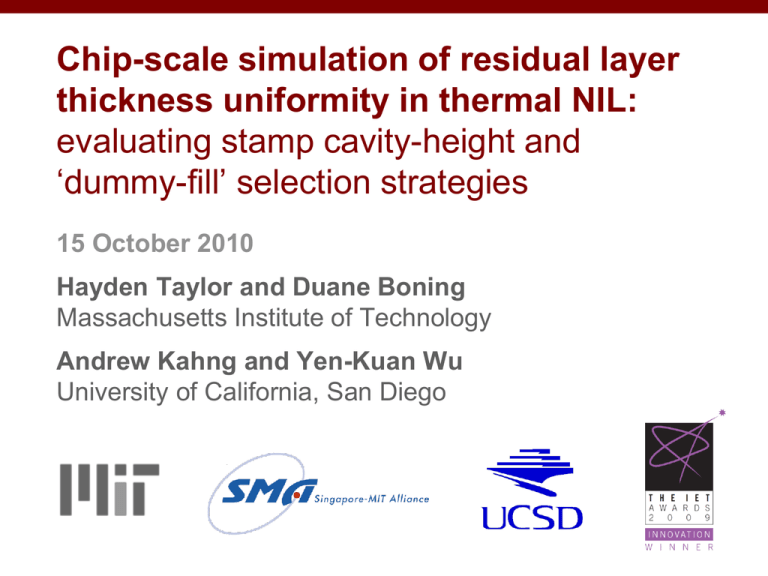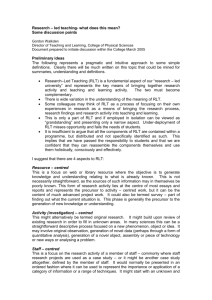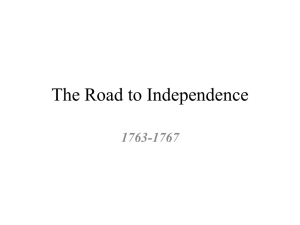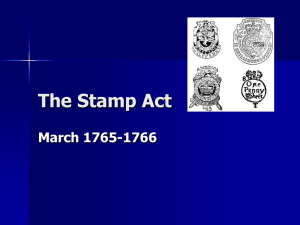presentation
advertisement

Chip-scale simulation of residual layer thickness uniformity in thermal NIL: evaluating stamp cavity-height and ‘dummy-fill’ selection strategies 15 October 2010 Hayden Taylor and Duane Boning Massachusetts Institute of Technology Andrew Kahng and Yen-Kuan Wu University of California, San Diego Residual layer thickness in thermal NIL exhibits pattern dependencies A common objective for Two relevant timescales nanoimprint-friendly design: for pattern formation: Limit time to fill cavities and to bring residual layer thickness variation within specification Local cavity filling NIL for planarization Stamp Planarizing material Residual layer thickness Substrate (RLT) homogenization Similarly, limit time to bring NILplanarized surface within spec. 2 Semiconductor designers are accustomed to satisfying pattern density constraints Not realistic in semiconductors Pattern density already constrained to a modest range (typ. 40-60%) → Insert non-functional (‘dummy’) features on the stamp 3 We use simulation to investigate the potential benefit of dummy fill to thermal NIL Local relationships between pressure history and RLT: Abstractions: Stamp: pointload response Resist: impulse response Wafer: point-load response HK Taylor and DS Boning, NNT 2009; SPIE 7641 (2010) 4 Our NIL simulation technique has been experimentally validated PMMA 495K, c. 165 °C, 40 MPa, 1 min HK Taylor and DS Boning, NNT 2009; SPIE 7641 (2010) 5 Our NIL simulation technique has been experimentally validated PMMA 495K (200 nm), 180 C, 10 min, 16 MPa, 10 replicates cavity protrusion 1 mm A B C D E F G Residual layer thickness (micron) 550 nm-deep cavities: Si stamp Exp’t Simulation A B C D E F G H H Cavity proportions filled Lateral position (mm) If imprinted layer is an etch-mask, RLT specifications depend on resist properties • (h + rmax)/rmax must be large enough for mask to remain intact throughout etch process • Largest allowable rmax – rmin is likely determined by lateral etch rate and critical dimension specification 7 Cavity-filling time depends on length-scale of pattern-density variation, and stamp stiffness 8 Time to satisfy target for RLT uniformity scales as ~W2 for Δρ above a threshold 9 We postulate a cost function to drive the insertion of dummy fill into rich designs 2 N W 1 1 tˆfill i 2 2 i 0 16 p0 r0 h 1 0 r0 h 1 0 i 2 Wi • • • • • Abutting windows of size Wi swept over design Δρi is maximal density contrast between abutting windows in any location Objective is to minimize sum of contributions from N+1 window sizes h: protrusion height on stamp r0: initial resist thickness 10 A simple density-homogenization scheme offers faster filling and more uniform RLT Characteristic feature pitch (nm) Metal 1 of example integrated circuit: min. feature size 45 nm 104 Stamp protrusion pattern density: without dummy fill 1 103 102 0.5 Predominant feature orientation 0 100 µm 11 A simple density-homogenization scheme offers faster filling and more uniform RLT Density: without fill Density: with fill Designed protrusion Available for dummy 1 µm 1 0.5 100 µm 0 12 A simple density-homogenization scheme offers faster filling and more uniform RLT 13 If stamp cavities do not fill, smaller RLTs are possible but RLT may be less uniform 14 Increasing ‘keep-off’ distance may reduce IC parasitics, but degrades RLT performance MFS: minimum feature size KOD: keep-off distance IC: integrated circuit 15 Summary • Simulations indicate that dummy-fill can accelerate cavity-filling and reduce RLT variation in thermal NIL • A plausible objective function has been proposed, to help minimize filling time and RLT variation • Tall, non-filling stamp cavities permit smaller average RLT but not necessarily greater uniformity • Spacing rules for NIL fill insertion may need to be far more aggressive than for existing IC dummy fill 16 Outlook • In an integrated circuit design with multiple layers, fill insertion will ideally be co-optimized for all layers • Dummy-fill is just one of several possible Mechanical Proximity Correction1 strategies: • Insert dummy fill based on density alone (as here) • Tune dummy feature shapes and sizes, as well as density • Manipulate feature edges in the non-filling cavity case 1 HK Taylor and DS Boning, NNT 2009; SPIE 7641 (2010) 17 Acknowledgements • Funding • The Singapore-MIT Alliance • Colleagues • Matt Dirckx, Eehern Wong, Melinda Hale, Aaron Mazzeo, Shawn Chester, Ciprian Iliescu, Bangtao Chen, Ming Ni, and James Freedman of the MIT Technology Licensing Office • Helpful discussions • Hella Scheer, Yoshihiko Hirai, Kristian Smistrup, Theodor Kamp Nielsen, Brian Bilenberg, and Dave White. 18









